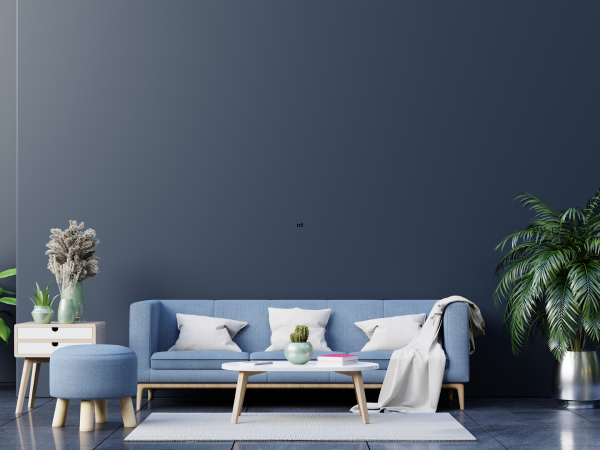
Strategies for choosing the best wall colour for your living room
Your living room is a place to eat, rest, entertain, or simply get some ‘me time’. Choosing the right wall colour sets the tone for a cosy and inviting space.
Whether you’re upgrading your home for a sale or rental or simply need a much-needed makeover, a splash of colour will make an impact. This guide is a treasure trove of wall colour strategies guaranteed to turn your living room into a sanctuary to live for.
Share this Post
Find your colour inspiration
Flicking through design magazines and catalogues is a good way to spark ideas for your living room. Take notes on colours that speak to you and combinations that will work for your space.
Of course, the colour journey doesn’t have to stop with print. Head online, scroll through Instagram, or start pinning your favourite schemes on Pinterest. At the end of the day, you don’t want to be disappointed by what your living could have been so expose yourself to all the creative looks out there.
Sample colours before committing
By doing your homework, you can avoid unnecessary expenses. Head over to your local paint shop and gather paint swatches in shades you’re leaning towards.
Once you’ve narrowed your choices, buy sample colours and paint areas of your living room wall; view this at different times of day to see how they change with the light. You can also paint a piece of wood and hold them to your flooring and furnishings to see how they work together.
Technology can also come to the rescue. Paint colour apps such as Dulux Visualizer can help you picture what colours look like on your walls using augmented reality.

Match colours to fabrics and furniture
If you don’t plan on changing up your living room’s decor and furnishings, your paint colour should complement everything within the space. Neutral furniture, carpets, curtains and blinds, and cushions will work with most colours. However, if they are a bold or bright shade, you’ll want to use them as the basis for choosing your colour palette.
They can even help you choose a colour if you’re stuck. Pick a piece of furniture or decor that has emotional or sentimental appeal. Then find sample colours with hues of its primary colour; this gives you options to play around with.
Consider the mood you’re after
What is the function of your living room? Do you plan on inviting friends over for game nights? Will it be a quiet space to relax? Or, will it also be a home office for work and study? Asking yourself these questions can help you pinpoint the type of mood you want to create — and the wall colour needed to make it a reality. Here are some of the best living room paint colours you can use:
- Living room colours that relax: For a tranquil atmosphere, look to cool colours like beachy blues and mint greens. Neutrals like white, grey, and beige also soothe and relax. You can also consider lavender and dusty pinks for a calming space.
- Living room colours that brighten: If you’re after warmth and light, look to sunny yellow shades, lavender, powder blue, pastel or rose pink, and soft greys.
- Living room colours for a bigger space: Neutral colours are wonderful for maximising space. Opt for stark white, taupe, and grey. For bolder shades, paint your living room with navy, pastel yellow, or sea green. Sparing uses of black can even create depth and a sense of grandeur.
Why stop at just one colour? You can captivate with gorgeous living room wall colour combinations. For example, you can use a contrasting colour on a focus wall. Or, you can use a monochromatic paint scheme and colour your walls in dark and light shades of the same colour.
Pay attention to your lighting
Your room’s light, both natural and artificial, can change how your colour is perceived. Natural daylight will show the truest version of your colour; if you have large, open windows in your living room, you can expect your colour to more or less follow the colour on your chart.
On the other hand, the bulbs of your living rooms have a colour temperature that changes your paint appearance. Lower temperatures indicating warmer tones, like those of incandescent bulbs, can intensify bright colours and wash out cool colours like blue and green. Higher temperatures bulbs emit cool tones that typically pair well with cool colours. Keep this in mind in addition to the position of your lighting. If your fixtures don’t cast even lighting, it can impact your paint’s appearance.
Create a colour flow between rooms
When choosing your paint colour, remember to think about the big picture. Your living room connects to other parts of your home so it should have a cohesive palette. You don’t have to paint it the same as other rooms but there should be some uniform colour that pulls each room together. Another way to create a sense of harmony is by painting it in lighter or darker shades of an adjoining room. The less jarring your living room colour feels, the more you’ll be able to appreciate it.
Consult with a colour expert
Depending on the quality of paint you choose, it can be a pricey investment. Plus, you’ll likely paint again only after some years have passed. Seeking the services of a professional can help you land on a colour you won’t regret. Put together ideas for their consultation but be open to the advice they present. They may even suggest changes in your lighting to help you get the most from your paintwork.
Paint can play an important role in increasing the value of your home and making it appealing to buyers and sellers. Our property professionals can help you decide on colours that have mass appeal. Get in touch with a branch near you.







